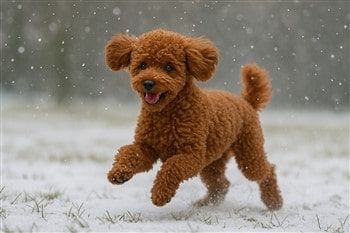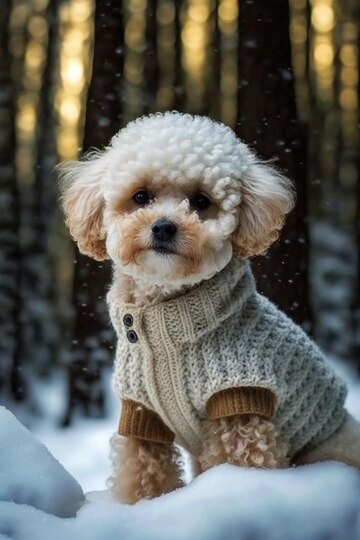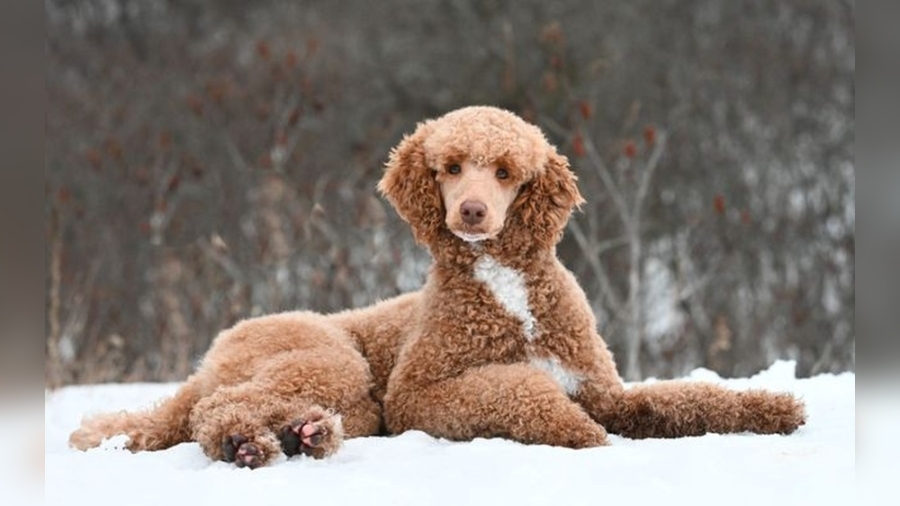Have you ever wondered if your poodle feels chilly when the temperature drops? You might notice your furry friend shivering or hesitating to go outside, and it makes you ask, “Do poodles get cold?” Understanding how your poodle reacts to cold weather is key to keeping them happy and healthy.
You’ll discover the signs that your poodle might be cold, why their unique coat doesn’t always protect them, and simple ways you can help your pet stay warm during those brisk Austin mornings or chilly winter walks. Keep reading to make sure your poodle stays cozy no matter the weather!
Poodles And Cold Weather
Poodles have a unique coat that affects how they handle cold weather. Their curly hair looks thick but offers less warmth than fur. This difference makes poodles more sensitive to chilly temperatures.
Many poodle owners notice their dogs shiver or try to find warm spots when it gets cold. Understanding how cold affects poodles helps keep them safe and comfortable all winter.
Why Poodles Feel Cold Easily
Poodles have hair, not fur, which grows continuously. Their coat is single-layered and lacks the thick undercoat that protects other breeds. Grooming and clipping remove much of their natural insulation. These factors make poodles lose body heat faster in cold weather.
Watch for shivering or trembling. A cold poodle may tuck its tail or hunch its body. Reluctance to walk outside or seeking shelter are clear signals. Lifting paws off cold ground shows discomfort. These signs mean your poodle needs warmth and care.
How To Keep Your Poodle Warm
Provide insulated jackets or sweaters to protect against cold air. Choose water-resistant coats to keep snow and rain away. Warm bedding inside the house helps maintain body heat. Avoid long exposure to cold without proper protection.

Signs Your Poodle Is Cold
Poodles have unique coats that may not protect them well in cold weather. Knowing the signs of cold helps keep your poodle safe. Watch for changes in behavior or body language.
Recognizing these signs early can prevent discomfort or health issues. Your poodle cannot tell you when they feel cold. You need to observe closely.
Shivering Or Trembling
Shivering is a clear sign your poodle feels cold. It is their body trying to create warmth. If your poodle trembles often, it needs warmth quickly.
Hunched Posture And Tucked Tail
A poodle that is cold often curls up or hunches its body. They tuck their tail close to conserve heat. This posture shows they are trying to protect themselves from the cold.
Reluctance To Move
Cold poodles may stop walking or want to turn back inside. They become reluctant to continue outside. If your poodle seems unwilling to move, it might be too cold for them.
Lifting Paws Off The Ground
Poodles often lift their paws if the ground feels too cold. This is a sign of discomfort. Watch if your poodle keeps lifting paws during a walk.
Seeking Shelter
Your poodle may look for places to hide or find shelter. They want to escape the cold wind or snow. This behavior shows they need a warmer spot.
Whining Or Barking
Cold poodles sometimes whine or bark more than usual. This vocalizing signals distress or discomfort. Pay attention to sudden changes in sound or tone.
Why Poodles Need Extra Warmth
Poodles have a unique coat that needs special care in cold weather. Their curly hair is different from the thick fur many dogs have. This difference makes them more sensitive to cold temperatures.
Many poodles get regular haircuts that reduce their natural protection. Without thick fur, they lose the ability to keep warm by themselves. They can feel the cold more quickly, especially outdoors.
Because of this, poodles often need extra warmth. Owners should provide warm clothing and cozy spaces to help keep them comfortable. Understanding why poodles need this care helps keep them healthy and happy in winter.
Single-layer Coat Offers Less Insulation
Poodles have a single-layer coat made of curly hair, not thick fur. This type of coat does not trap heat well. It lets cold air reach their skin easily. This means poodles lose body heat faster than other dogs.
Regular Grooming Reduces Natural Protection
Poodles are often groomed with short haircuts. Grooming removes the longer hair that can protect against cold. After grooming, their skin is more exposed to cold air and wind. This makes them feel cold sooner.
Signs Poodles Show When They Are Cold
Poodles shiver or shake when they feel cold. They may curl up or tuck their tail close to their body. Some poodles seem tired or do not want to go outside. Watching for these signs helps owners act quickly.
Need For Warm Clothing And Shelter
Warm coats and sweaters help poodles keep their body heat. Clothes made for dogs block cold wind and wet weather. A cozy bed inside also gives them a warm place to rest. These steps protect poodles from cold stress.
Choosing The Right Winter Coat
Choosing the right winter coat for your poodle is essential for their comfort and health. Poodles have a single layer of curly hair that does not keep them warm enough in cold weather. A good coat protects them from wind, snow, and rain. It also helps maintain their body heat during chilly walks.
Winter coats come in many styles and materials. Picking the right one can make a big difference in how your poodle feels outside. Consider factors like warmth, fit, and weather resistance. A well-chosen coat keeps your poodle happy and active all winter long.
Insulation And Warmth
Look for coats with good insulation to trap body heat. Materials like fleece or padded nylon work well. The coat should cover your poodle’s body without restricting movement. Insulation helps your dog stay warm even in freezing temperatures.
Water Resistance
Choose a coat that repels water. Poodles can get wet from snow or rain easily. A water-resistant or waterproof coat keeps your dog dry and comfortable. Wet fur loses its ability to insulate, making your poodle colder.
Proper Fit
A coat that fits properly is key. It should not be too tight or too loose. Check the neck, chest, and belly areas for snugness. A well-fitted coat stays in place during walks and prevents cold air from entering.
Ease Of Use
Select coats that are easy to put on and take off. Velcro straps or simple buttons help. Your poodle will tolerate wearing the coat better if it is comfortable and easy to wear. This makes winter outings stress-free for both of you.
When To Dress Your Poodle
Dressing your poodle is important for their comfort and health. Poodles have a single-layer coat that does not keep them very warm. Their fur is often clipped short, which lowers natural insulation. Knowing when to dress your poodle helps protect them from cold weather. Watch for signs that your poodle may need extra warmth outdoors or inside.
Cold Weather Outside
When temperatures drop below 45°F (7°C), your poodle may feel cold. Short-haired or clipped poodles lose much of their warmth. Dress your poodle with a cozy sweater or jacket before going outside. Wet weather or snow makes your poodle colder faster. Use a water-resistant coat to keep them dry and warm.
Look for shivering or trembling as a clear sign of cold. Your poodle may tuck its tail or hunch its body to keep warm. Reluctance to walk or whining can mean discomfort. Cold paws lifted off the ground show your dog is chilly. Dressing your poodle helps stop these signs and keeps them happy.
Indoors And Nighttime Care
Sometimes your poodle feels cold inside the house too. Older or smaller poodles may need extra warmth at night. A soft sweater or blanket in their bed helps them stay cozy. Keep their sleeping area away from drafts. Dressing your poodle indoors during cold months supports their comfort and health.

Indoor Warmth Tips For Poodles
Keeping your poodle warm indoors is important, especially during cold months. Poodles can feel chilly inside, just like outside. Their single-layer coats do not trap much heat, so extra care helps them stay comfortable. A warm home makes your poodle happy and healthy.
Provide A Cozy Sleeping Area
Choose a soft bed with thick padding for your poodle. Place it away from drafts or cold floors. Adding a blanket helps trap heat. Make the spot quiet and calm. This gives your poodle a warm, safe place to rest.
Use Pet-safe Heating Pads
Heating pads made for pets offer gentle warmth. Place the pad under their bed or blanket. Always check the temperature to avoid burns. Turn it off when not in use. This keeps your poodle warm without overheating.
Dress Your Poodle In Warm Clothing
Light sweaters or jackets add extra warmth indoors. Choose soft, breathable fabrics that fit well. Avoid tight or heavy clothes that restrict movement. Clothes help keep your poodle cozy, especially if your home is cool.
Block Drafts And Cold Air
Seal windows and doors to reduce cold air inside. Use draft stoppers or curtains to keep warmth in. Check vents for cold air leaks. A warmer room means your poodle stays comfortable throughout the day.
Maintain Comfortable Room Temperature
Keep indoor temperatures steady between 68°F and 72°F (20°C to 22°C). Avoid sudden temperature drops. Use heaters safely and monitor your poodle’s behavior. Warm air helps prevent shivering and discomfort indoors.
Protecting Poodle Paws In Winter
Protecting poodle paws in winter is very important. Cold weather, ice, and salt can hurt their delicate feet. Poodles have sensitive paw pads that can crack or get sore from harsh winter conditions. Taking care of their paws helps keep them healthy and happy during cold months.
Snow and ice can build up between paw pads. This causes discomfort and makes walking painful. Salt and chemicals used to melt ice can irritate and burn paws. Without protection, poodles may limp or refuse to go outside. Proper paw care prevents these problems.
Keep Poodle Paws Clean And Dry
After walks, clean your poodle’s paws with warm water. Remove any snow, ice, or salt stuck between toes. Dry paws thoroughly to avoid cracking and infections. Moisture left on paws can cause skin problems in cold weather.
Use Paw Balm For Extra Protection
Apply paw balm or wax to your poodle’s pads before going outdoors. These products create a barrier against cold surfaces and salt. They also keep paw pads soft and prevent dryness. Choose balms made for dogs to ensure safety.
Consider Dog Booties For Harsh Conditions
Dog booties protect paws from extreme cold, ice, and salt. They give better grip on slippery surfaces. Booties keep paws warm and dry during long outdoor activities. Introduce booties slowly so your poodle gets used to wearing them.
Trim Hair Around Paws
Trim the hair between paw pads to reduce ice buildup. Long hair traps snow and ice, causing discomfort. Regular trimming helps keep paws clean and free from debris. Use blunt scissors carefully to avoid injury.
Winter Exercise Safety
Exercise is important for poodles all year round. Winter brings cold temperatures that can affect their health. Safety during cold-weather exercise is key. Protect your poodle from the harsh winter elements. Keep walks short and frequent rather than long and tiring. Watch your dog closely for signs of cold stress.
Proper gear helps keep your poodle warm and comfortable. A good winter coat or sweater is essential. It shields your poodle from wind and moisture. Paw protection is also important to prevent frostbite and ice injuries. Use booties or paw balm on cold surfaces. Avoid icy or salted roads as they can hurt paws.
Signs Your Poodle Is Too Cold
Look for shivering or trembling during walks. Your poodle may lift paws off the cold ground. A hunched posture or tucked tail shows discomfort. Whining or trying to turn back is a clear sign. Watch for slow movements or reluctance to walk. These signals mean it is time to go inside.
Choosing Winter Clothing
Pick clothing made from warm, water-resistant materials. The coat should cover the chest and belly well. A snug fit keeps warmth in but avoid tightness. Layering can add extra warmth on very cold days. Make sure your poodle can move freely in the outfit. Remove wet clothing quickly to prevent chilling.
Safe Places For Winter Play
Select areas free of ice and snow buildup. Avoid frozen ponds or lakes to prevent accidents. Soft snow is better for paws than hard ice. Keep your poodle away from salted sidewalks. Salt can irritate paws and cause illness if ingested. Choose open, clear spaces where your dog can run safely.
Special Care For Puppies And Seniors
Puppies and senior poodles need extra care in cold weather. Their bodies cannot keep warm easily. Puppies have small bodies and less fat to protect them. Older poodles may have weaker immune systems and joint issues. These factors make them more sensitive to cold.
Providing warmth and comfort is key for their health. Watch for signs of cold stress like shivering or reluctance to move. Adjust their environment and clothing to suit their needs.
Warm Clothing For Extra Protection
Dress puppies and seniors in warm jackets or sweaters. Choose clothes that fit well and cover their chest and belly. Use insulated materials to trap body heat. Clothes should be easy to put on and take off. Remove wet clothing quickly to prevent chills.
Comfortable And Cozy Sleeping Areas
Provide soft beds away from drafts and cold floors. Use blankets that hold heat well. Raise beds slightly off the ground to avoid cold surfaces. Keep their sleeping area dry and clean. Change bedding often to maintain warmth.
Limit Outdoor Time During Cold Weather
Keep walks short for puppies and senior poodles. Avoid exposure to snow, ice, and strong winds. Monitor their behavior outside closely. Bring them indoors if they show signs of discomfort. Plan outdoor activities during the warmest parts of the day.

Frequently Asked Questions
How Do I Know If My Poodle Is Cold?
Signs your poodle is cold include shivering, hunched posture, whining, lifting paws, reluctance to walk, and seeking shelter.
Do Poodles Get Cold In The House?
Poodles can feel cold indoors, especially if the house is chilly. Dress them in sweaters and provide cozy bedding to keep them warm.
Do Poodles Need Jackets In The Winter?
Yes, poodles need jackets in winter due to their single-layer coat and frequent grooming. Jackets keep them warm and dry.
Is A Poodle Afraid Of Cold?
Poodles can feel cold due to their single-layer coat. They may shiver or seek warmth. Use jackets in cold weather.
Conclusion
Poodles can feel cold, especially in winter or wet weather. Their thin, single-layer coats do not keep heat well. Watch for signs like shivering or reluctance to go outside. Providing a warm, well-fitting jacket helps protect them. Keep your poodle dry and comfortable during cold days.
Regular grooming can reduce their natural insulation. Always check the weather before outdoor walks. Keeping your poodle warm ensures they stay happy and healthy. Simple care makes a big difference in cold weather.

